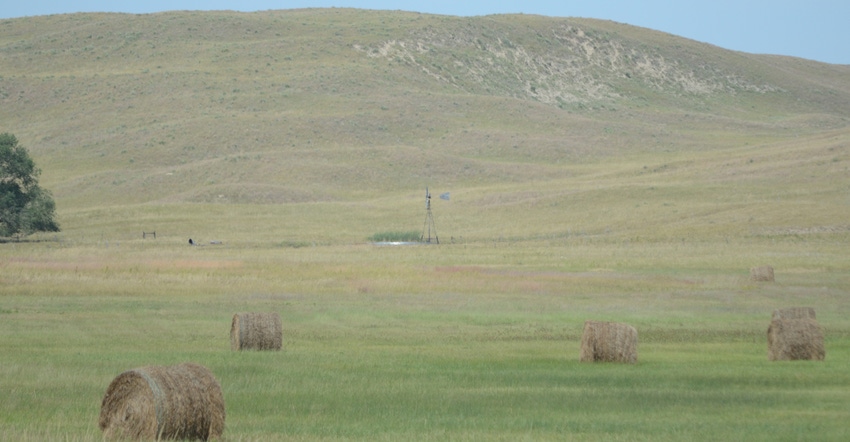November 11, 2019

With the wet weather this year, putting up quality hay and keeping it protected from the elements has been a challenge. While some weathering of bales is to be expected, those that were put up a bit wet, have been sitting in water or were otherwise saturated need some special considerations.
The first thing to keep in mind when dealing with wet hay is that moisture can easily lead to combustion. Twenty percent moisture is about the highest level that bales should reach. Above this, microbes begin to break down plant matter and mold growth occurs. This breaking down of hay produces heat and leads to the danger of combustion.
Store bales that have a risk of overheating outside and away from other bales to limit the risk of a fire spreading. Check temperatures on these bales by using a long-stem compost thermometer or driving a metal pipe into the bale and lowering in a non-mercury thermometer.
Any bales at 170 degrees F or higher should be closely monitored; at this point temperatures will most likely continue to rise. Bale combustion can begin at temperatures as low as 190 degrees, especially in coarse hays like sorghum-sudangrass hybrids. Increased oxygen flow in these bales due to the coarse stems means higher risk. Moving hot bales can also open them up and increase oxygen flow, once again increasing the risk of combustion.
Even if they are not at risk for fire, wet bales will continue to decrease in quality. Mold will often occur, which uses plant tissues as an energy and protein source for growth, resulting in decreased quality. Hot temperatures denature cell structures, which changes the nature of proteins and carbohydrates, making them less useful for the animal when digested.
In some cases, with anaerobic conditions, hay may "caramelize," becoming golden-colored and sweet-smelling. While highly palatable, this heat-fermented hay is also lower in quality due to the nature of the fermentation process.
Dealing with moldy hay
So, if you have wet hay showing one or more of these signs, what do you do?
Mold is one of the first issues on most producer's minds. Mold has the potential to produce mycotoxins, which in high enough levels, could be deadly to animals that ingest it in extreme circumstances.
The moderate side effect is reduced intake, a decrease in ruminal function and overall reduced performance of the animal, leading to economic losses. While this may seem minor in the scope of a year's time for a cow, the lowered feed values of forages due to increased rain and extended winters amplify the potential for poor breed-up and decreased calf weights.
The best way to use moldy hay is to spread out bales and let animals pick through, with a second source of clean hay for them to select from as well. Mold often reduces palatability and animals will avoid especially bad chunks. Having clean hay available ensures animals aren't forced to eat anything they don't choose to.
Pregnant animals are more sensitive to mycotoxin poisoning, which can lead to fetal abortion, so consider limiting how much moldy hay these animals receive. Horses are highly sensitive to mold in hay, with the danger of both respiratory and toxin issues. As such, keeping moldy hay away from horses is advisable.
Mold can also be a health risk to the producer. Frequently breathing in large amounts of dust and mold can cause respiratory issues such as farmer's lung. To protect against this, wear a dust mask when working with hay that may have high amounts of mold.
Don't forget to test
Last and arguably most important, hay testing is going to be especially critical this year. Determining actual, as-fed hay quality is important to meet animal nutrition needs through the winter. If moldy hay is being ground for a diet, getting the correct dilution rate to ensure bad hay isn't being overfed will be critical, since animals won't have the option for refusal.
Mold and mycotoxin tests can be a bit expensive, and not all labs even offer these tests. Your local University of Nebraska Beef Extension educator can help identify a lab and determine a cost-effective sampling strategy.
Until bales cool off and moisture content drops below 20%, quality of hay will continue to drop through the year. To ensure an accurate assessment of hay quality, sample by lot (hay harvested from the same field within a 48-hour period) a few weeks before you plan to feed.
An earlier sample could be done to get a general idea of quality for planning purposes, but since the degradation process in these bales is ongoing, we won't be able to get a true reading until right before feeding. This should give an accurate idea of hay quality while still giving the lab time to get results back to you. Knowing the quality of your hay allows for better decisions about how to use low-quality forage and prevent animals from being underfed.
Beckman and Greenwell are Nebraska Extension educators.
Source: This report comes from UNL BeefWatch, which is solely responsible for the information provided and is wholly owned by the source. Informa Business Media and all its subsidiaries are not responsible for any of the content contained in this information asset.
You May Also Like




